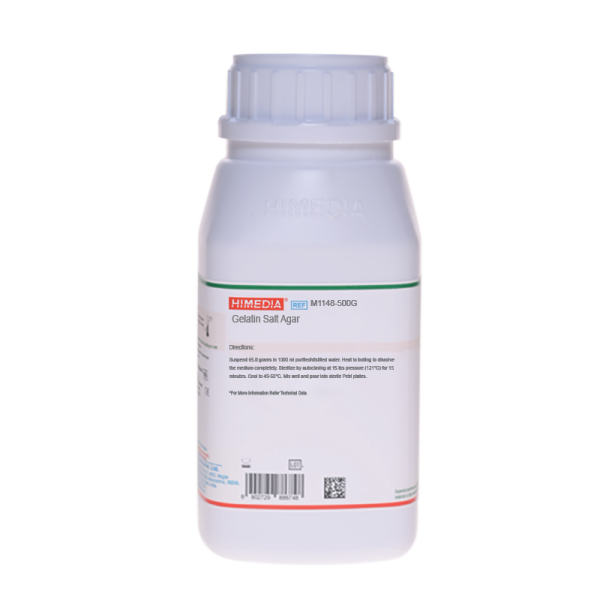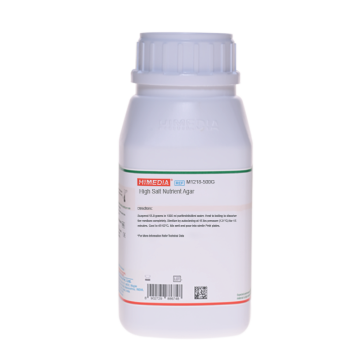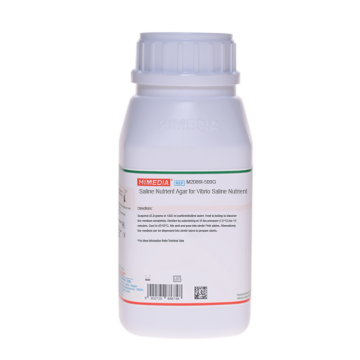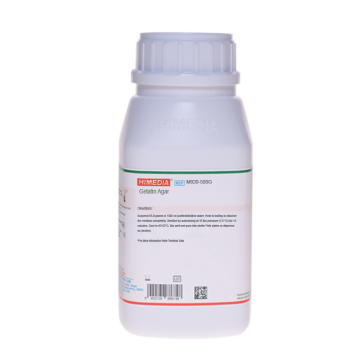 Your enquiry has been submitted
Your enquiry has been submitted
Gelatin Salt Agar
Vibrio species#CC293D
Intended Use
Recommended for cultivation and differentiation of Vibrio species from food.
Composition**
| Ingredients | Gms / Litre |
|---|---|
| Gelatin | 15.000 |
| Peptone | 4.000 |
| Yeast extract | 1.000 |
| Sodium chloride | 30.000 |
| Agar | 15.000 |
Final pH (at 25°C): 7.2±0.2
**Formula adjusted, standardized to suit performance parameters
Directions
Suspend 65.0 grams in 1000 ml purified/distilled water. Heat to boiling to dissolve the medium completely. Sterilize by autoclaving at 15 lbs pressure (121°C) for 15 minutes. Mix well and pour into sterile Petri plates.
Principle And Interpretation
Vibrio's are fairly easy to isolate from both clinical and environmental material, though some species may require growth factors and/or vitamins. Media can be made selective for Vibrio's by adding appropriate selective agents (1). High concentrations of NaCl and alkaline pH have also been used to select certain Vibrio species, based on the ability of most Vibrios to grow at pH values above 8.0 and at 3% or higher concentrations of NaCl. Vibrio species which require high sodium chloride concentration for growth are called Halophilic or Halophiles. Gelatin Salt Agar is used to screen isolates for salt tolerance (6). As only halophillic Vibrio species grow on Gelatin Salt Agar, it is recommended to inoculate Gelatin Agar (M920) in addition (2). An opaque halo is observed around growth of gelatinase positive organisms.
Peptone and yeast extract provides essential nutrients required for growth of Vibrio species. Gelatin serves as a substrate for gelatinase reaction. Sodium chloride maintains the osmotic equilibrium of the medium.
Type of specimen
Food samples
Specimen Collection and Handling
For food samples, follow appropriate techniques for sample collection and processing as per guidelines (5).
After use, contaminated materials must be sterilized by autoclaving before discarding.
Warning and Precautions
Read the label before opening the container. Wear protective gloves/protective clothing/eye protection/ face protection. Follow good microbiological lab practices while handling specimens and culture. Standard precautions as per established guidelines should be followed while handling specimens. Safety guidelines may be referred in individual safety data sheets.
Limitations
- It require a settling period before pH testing of the prepared medium. If the pH is tested immediately after preparation and is out of specification, retest the medium after 24 hours to obtain the specified pH.
- Further biochemical and serological tests must be carried out for further identification.
Performance and Evaluation
Performance of the medium is expected when used as per the direction on the label within the expiry period when stored at recommended temperature.
Quality Control
Appearance: Cream to yellow homogeneous free flowing powder
Gelling: Firm, comparable with 1.5% Agar gel and 1.5% Gelatin gel
Colour and Clarity of prepared medium
Light yellow coloured, clear to slightly opalescent gel forms in Petri plates
Reaction: Reaction of 6.5% w/v aqueous solution at 25°C. pH: 7.2±0.2
pH: 7.00-7.40
Cultural Response
Cultural characteristics observed after an incubation at 35-37°C for 18-24 hours.
| Organism | Growth | Gelatinase reaction |
|---|---|---|
| Vibrio cholerae ATCC 15748 | luxuriant | positive reaction, opaque halo around the colony |
| Vibrio parahaemolyticus ATCC 17802 (00037*) | luxuriant | positive reaction, opaque halo around the colony |
| Vibrio vulnificus ATCC 29306 | luxuriant | positive reaction, opaque halo around the colony |
| Vibrio mimicus ATCC 33653 | luxuriant | positive reaction, opaque halo around the colony |
Key: *Corresponding WDCM numbers.
Storage and Shelf Life
Store between 10-30°C in a tightly closed container and the prepared medium at 20-30°C. Use before expiry date on the label. On opening, product should be properly stored dry, after tightly capping the bottle in order to prevent lump formation due to the hygroscopic nature of the product. Improper storage of the product may lead to lump formation. Store in dry ventilated area protected from extremes of temperature and sources of ignition. Seal the container tightly after use. Product performance is best if used within stated expiry period.
Disposal
User must ensure safe disposal by autoclaving and/or incineration of used or unusable preparations of this product. Follow established laboratory procedures in disposing of infectious materials and material that comes into contact with sample must be decontaminated and disposed of in accordance with current laboratory techniques (3,4).
Reference
- Bruno Gomez-Gil and Ana Roque, Isolation, Enumeration and Preservation of the Vibrionaceae, F.L. Thompson, B. Austin and J. Swings, The Biology of Vibrios, ASM press.
- FDA Bacteriological Analytical Manual, 2005, 18th Ed., AOAC, Washington, D.
- Isenberg, H.D. Clinical Microbiology Procedures Handbook 2nd Editio
- Jorgensen, J.H., Pfaller, M.A., Carroll, K.C., Funke, G., Landry, M.L., Richter, S.S and Warnock., D.W. (2015) Manual of Clinical Microbiology, 11th Edition. Vol. 1.
- Salfinger Y., and Tortorello M.L. Fifth (Ed.), 2015, Compendium of Methods for the Microbiological Examination of Foods, American Public Health Association, Washington, D.C.
- Smith Jr. H. L. and Goodner K., 1958, J. Bacteriol., 76:66
| Product Name | Gelatin Salt Agar |
|---|---|
| SKU | M1148 |
| Product Type | Regular |
| Physical Form | Powder |
| Origin | Animal |
| Packaging type | HDPE |
| References | 1.Bruno Gomez-Gil and Ana Roque, Isolation, Enumeration and Preservation of the Vibrionaceae, F.L. Thompson, B. Austinand J. Swings, The Biology of Vibrios, ASM press.2.Smith Jr. H. L. and Goodner K., 1958, J. Bacteriol., 76:662.3.FDA Bacteriological Analytical Manual, 2005, 18th Ed., AOAC, Washington, D.C. |
| Customized Product Available | No |











